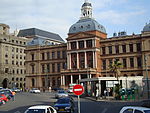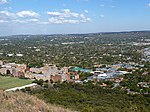Kruger House, Pretoria

Kruger House is the historical Pretoria residence of the Boer leader and President of the South African Republic, Paul Kruger. It was built in 1884 by architect Tom Claridge and builder Charles Clark. Milk was used, instead of water, for mixing the cement from which the house was constructed, as the cement available was of poor quality. The house was also one of the first in Pretoria to be lit by electricity. The house contains either the original furnishings or items from the same historical period, some of the many gifts that were presented to Kruger as well as other memorabilia. Another interesting feature of the house is two stone lions on the verandah that were presented to President Kruger as a birthday gift on 10 October 1896 by the mining magnate Barney Barnato. The Kruger House is now a house museum that tries to recreate the ambience of the period that Kruger lived in.
Excerpt from the Wikipedia article Kruger House, Pretoria (License: CC BY-SA 3.0, Authors, Images).Kruger House, Pretoria
W.F. Nkomo Street, Pretoria Tshwane Ward 58
Geographical coordinates (GPS) Address Phone number Website External links Nearby Places Show on map
Geographical coordinates (GPS)
| Latitude | Longitude |
|---|---|
| N -25.746388888889 ° | E 28.181388888889 ° |
Address
Kruger House
W.F. Nkomo Street 60
0126 Pretoria, Tshwane Ward 58
Gauteng, South Africa
Open on Google Maps







